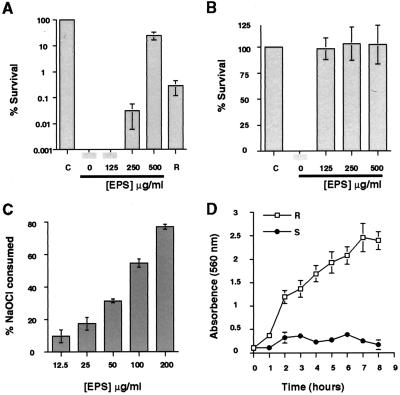Figure 2.
EPSETr-mediated survival in chlorine and biofilm formation by the rugose and smooth colonial variants. (A) Smooth-type bacteria were incubated for 5 min with 3 ppm chlorine (NaOCl) and the indicated concentrations of purified EPSETr. The surviving bacteria were enumerated by viable plate counts, and their numbers were compared with the number of surviving smooth bacteria that had not been incubated with NaOCl, denoted by C; this number was defined as 100% survival. Increasing survival of the smooth variant in chlorine was conferred by EPSETr concentrations of 250 and 500 μg/ml. Rugose and smooth bacteria, incubated with 3 ppm NaOCl in the absence of exogenous EPSETr, denoted by R and 0, respectively, revealed differences between the intrinsic resistances of the two colonial variants to the bactericidal activity of chlorine. (B) Preincubation of NaOCl (3 ppm) with the indicated concentrations of EPSETr for 5 min before the addition of smooth-type bacteria increased the protective effect of the polysaccharide. C denotes the survival of smooth-type bacteria in the absence of NaOCl and EPSETr. (C) Consumption of free chlorine by purified EPSETr. NaOCl (6 ppm) and the indicated concentrations of EPSETr were incubated in PBS for 1 min at 22°C, and the free chlorine concentration then was determined by the syringaldazine method. EPSETr caused rapid, concentration-dependent consumption of chlorine. (D) Quantitative analysis of biofilm formation by the smooth and rugose variants. Bacteria of each colony type (1–5 × 106 colony-forming units) were incubated in separate wells of a poly(vinyl chloride) microtiter dish for the indicated time periods, the wells were emptied and washed, and the adherent bacteria were stained with a 1% solution of crystal violet. The dye was solubilized by the addition of 95% ethanol, and the absorbance was determined at 560 nm. Progressive biofilm formation by the rugose variant is indicated by an increase in A560 during the experimental period.

